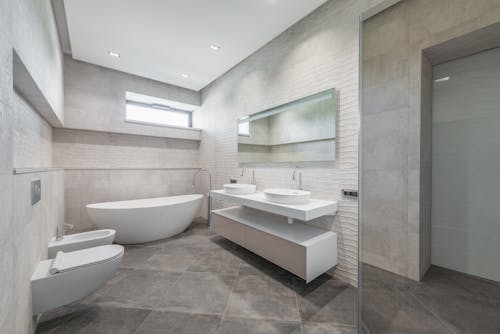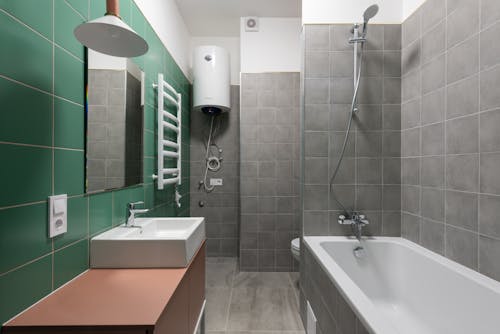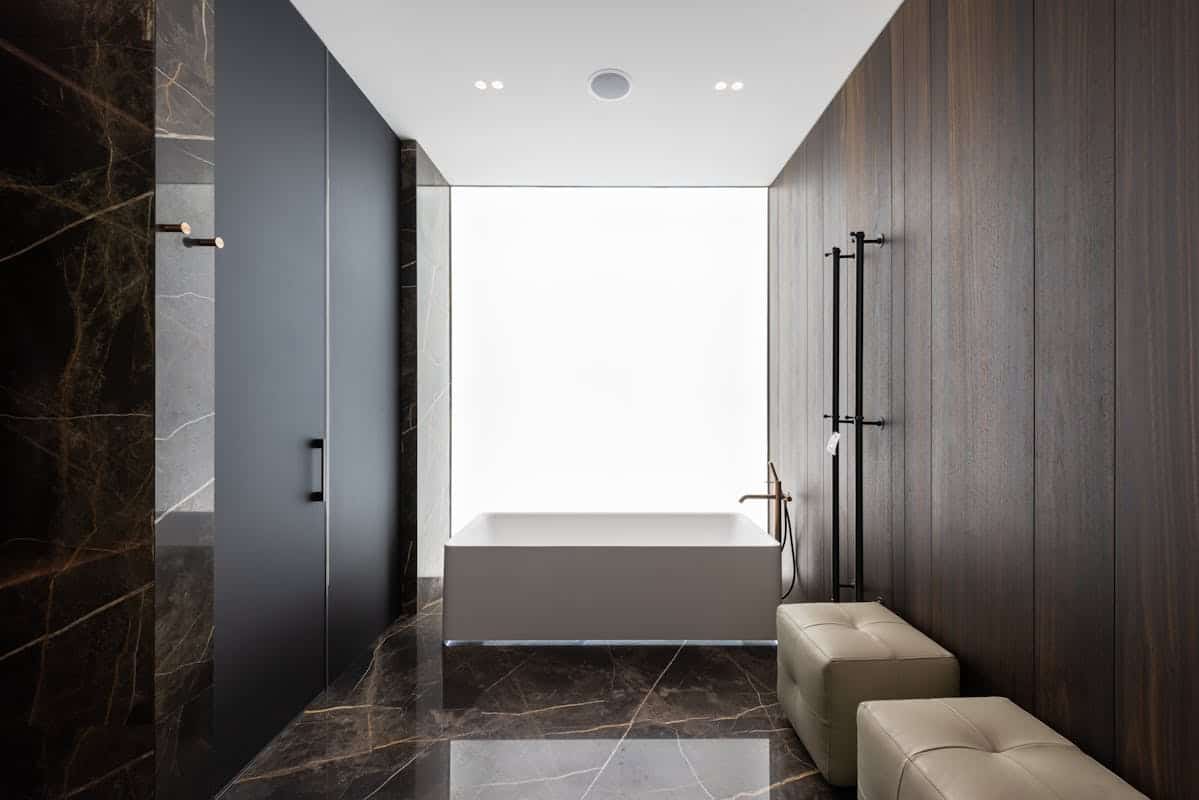Embarking on the journey of upgrading your bathroom brings with it the consideration of adding luxuries that enhance your comfort and the space’s overall value.
Among these enhancements, heated bathroom floors stand out as a sought-after feature, promising to transform your bathroom experience from merely functional to indulgently cozy.
The concept revolves around a system installed beneath your bathroom flooring that radiates heat upwards, ensuring the floor remains pleasantly warm underfoot.
This innovation is not only about luxury; it introduces a practical solution to the age-old discomfort of cold tiles, especially during the chillier months.
As we delve deeper into the nuances of heated bathroom floors, you’ll discover the myriad benefits they offer, the variety available, and the considerations necessary before making this transformative addition to your home.
Table of Contents
Benefits of installing heated floors in the bathroom

The allure of stepping onto a warm floor after a shower cannot be overstated. The first and most immediate benefit of heated bathroom floors is the sheer comfort they provide. No longer will you brace yourself for the shock of cold tiles against your feet; instead, you’ll enjoy a gentle warmth that extends throughout the room. This comfort also contributes to a healthier living environment. Traditional heating methods can circulate dust and allergens, but the radiant heat from the floor minimizes this circulation, maintaining cleaner air quality in your bathroom.
Moreover, heated floors are remarkably energy efficient. They utilize lower temperatures than standard heating systems to deliver consistent warmth, leading to potential savings on your energy bills. This efficiency doesn’t compromise their effectiveness; the heat distribution is even, eliminating cold spots and creating a uniformly cozy atmosphere. Additionally, this system adds a layer of luxury that increases your home’s value, appealing to potential buyers who value comfort and energy efficiency. As we explore the types of heated bathroom floors, you’ll see how this feature not only enhances your daily life but also serves as a wise investment in your property.
Different types of heated bathroom floors
When considering the installation of heated bathroom floors, you are presented with two primary options: electric and hydronic systems. Each comes with its unique advantages and considerations, tailored to different needs and preferences.
Electric systems utilize a network of electric wires installed beneath the flooring. These systems are praised for their ease of installation and the speed with which they heat up, making them particularly suitable for smaller areas such as bathrooms. They’re often controlled via a thermostat, allowing you to adjust the temperature to your liking. Their installation and operational costs can be higher, but for those seeking a straightforward solution to warm their bathroom floors, electric systems offer a compelling choice.
Conversely, hydronic systems rely on circulating heated water through pipes under the flooring. This option is celebrated for its efficiency, especially in homes that already use water-based heating. Although the initial installation can be more complex and costly, the operating expenses over time can be lower, making it an attractive option for those undertaking significant renovations or building a new home. Choosing between electric and hydronic systems depends on your specific circumstances, including your budget, the size of your bathroom, and your long-term heating needs.
Factors to consider when choosing heated bathroom floors

Selecting the right type of heated bathroom floor involves more than just picking between electric and hydronic systems. One must consider the flooring material, as not all materials conduct and retain heat with the same efficiency. Tiles, for example, are excellent conductors of heat, making them a popular choice for heated floors. However, if you prefer wood or laminate, you’ll need to ensure they’re compatible with underfloor heating and won’t warp or dry out from the heat.
Another crucial consideration is the insulation of your bathroom. Proper insulation ensures that the heat generated by the floor heating system is retained within the space, maximizing efficiency and comfort. Additionally, the size of your bathroom will influence the cost and type of system you choose. Larger spaces may benefit more from a hydronic system, while smaller bathrooms might be better suited to electric heating.
Lastly, consider the installation process itself. Retrofitting a heated floor into an existing bathroom requires significant upheaval, including the removal of the existing floor and potentially altering the height of the floor to accommodate the new system. This can affect everything from door clearance to the fit and finish of fixtures. Planning for these changes in advance can prevent unexpected complications during installation.
Cost of installing heated bathroom floors
The financial aspect of adding heated floors to your bathroom is a pivotal consideration. The total cost encompasses more than just the price of materials and labor; it also includes the preparatory work needed and any alterations to your bathroom’s structure. For electric systems, the average cost can range significantly based on the size of your bathroom and the complexity of the installation. Smaller bathrooms might see costs as low as a few hundred dollars, while larger spaces could require a more substantial investment.
Hydronic systems, with their more complex installation process, generally command a higher initial outlay. However, their operating costs can be lower, particularly if integrated into a home’s existing heating system. It’s also worth considering the long-term energy savings against the upfront costs. Regardless of the system you choose, it’s advisable to seek multiple quotes to ensure you’re getting the best value for your investment.
Steps involved in installing heated bathroom floors

Choosing between an electric or hydronic system will affect the installation procedure, but both require the same processes. To create room for the new heating elements, the old flooring and any necessary subflooring are first removed. In the case of electric systems, this includes first putting down heating mats or cables and then covering the heating elements with a tiny amount of thin-set concrete.
A more complicated procedure is needed for hydronic systems, which may involve laying pipes and maybe changing the floor structure to make room for them. Before the last layer of flooring material is put over the heating system, the floor is checked to make sure it functions properly. To guarantee the system operates as planned and prevent damage to the heating elements, this process calls for careful organization and precision.
Maintenance and care for heated bathroom floors
The lifetime and effectiveness of your heated bathroom flooring are ensured by regular maintenance. Fortunately, little maintenance is needed for both hydronic and electric systems. Regularly inspecting the thermostat and electrical connections on electric systems can help avert problems. On the other hand, hydronic systems gain from routine checks to make sure the pipes are free of obstructions and leaks.
Maintaining the performance of the system can also be aided by routinely cleaning your bathroom floors, depending on the type of flooring. Stay clear of abrasive cleaning supplies and aggressive chemicals that can harm the flooring or the heating components underneath. If you take good care of your heated bathroom flooring, they will last for many years and give you comfort and warmth.
Conclusion: Is installing heated bathroom floors worth it?
Weighing the comfort, energy efficiency, and added home value against the initial costs and installation process leads to a compelling case for installing heated bathroom floors. Whether you choose an electric or hydronic system, the benefits of stepping onto a warm floor on a cold morning are undeniable. With careful planning, the right choice of materials, and professional installation, heated bathroom floors can transform your bathroom into a haven of comfort and luxury. As with any significant home improvement, consider your needs, budget, and long-term plans for your home to decide if this investment is right for you.
Can heated floors be installed under any type of bathroom flooring?
Most types of flooring materials are compatible with heated floors, but some, like tile, conduct heat better than others. It’s important to check the compatibility of your chosen flooring material with the heating system.
Are heated bathroom floors safe?
Yes, when installed correctly, both electric and hydronic heated floors are safe and comply with building regulations. Ensure your system is installed by a qualified professional to guarantee safety.
How long do heated bathroom floors take to warm up?
Electric systems can heat up within 30 minutes to an hour, while hydronic systems may take longer due to the nature of circulating warm water. The exact time can vary based on the system and the specific installation.

